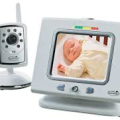 New mothers were once required to move their babies from one room to another in a Moses basket or simply restrict their activities so they were always within ear shot of their sleeping babies. With time, basinets with wheels were developed so babies could be wheeled through the house. Today, modern technology has blessed the new mother with wireless baby monitors. Now babies do not have to be moved, and mothers do not have to restrict their activities.
New mothers were once required to move their babies from one room to another in a Moses basket or simply restrict their activities so they were always within ear shot of their sleeping babies. With time, basinets with wheels were developed so babies could be wheeled through the house. Today, modern technology has blessed the new mother with wireless baby monitors. Now babies do not have to be moved, and mothers do not have to restrict their activities.
The Development of Wireless Monitors
The first baby monitors created had to be plugged into the wall. The transmitter and receiver had to stay close to a wall plug, and then a new plug had to be found when a unit was moved to a new location within the home. This was still a convenience in those early days of development, since parents previously had no monitors at all.
When the wireless baby monitor hit the market, convenience was taken to the next level. These systems do not require the receivers to be plugged into the wall, though sometimes the transmitter in the baby’s room will still need to be plugged in with some units. Some systems have optional plug-ins for those times you may not have fresh batteries on hand.
The next step forward was the video baby monitor, and you can now find those in wireless versions as well.
Most new mothers go with wireless baby monitors because it makes moving throughout the home much easier. The receiver can often be carried on the body, or it can be carried into a room and sat on a table. There are no wires to drag around and plugs do not have to be found in each room of the home. No more bending over tables or moving furniture to find an open spot to plug in the baby monitor!
A wireless transmitter unit can be placed anywhere in a baby’s nursery, while the wired versions are limited to locations with a plug close by. This is an extreme convenience for many new parents, since nurseries are not exactly set up with convenient placement of plugs in mind.
A wireless transmitter can also be moved around the house, so the baby can be put to rest outside of the nursery and the mother can still keep an active ear on their breathing and movement.
When wireless is an option, the only concern is ensuring the unit stays fully juiced with battery power at all times. It also eliminates appearance of wires hanging out all over the room. As the baby grows, toddlers can even be monitored without worrying they will play with the plugs and put themselves in danger.
Why Some Do Not Go With Wireless Baby Monitors
There are certainly more advantages than disadvantages to using wireless baby monitors, but there are some downsides to consider. Baby monitor reviews show that the biggest reason some parents choose not to go wireless is the annoying interference with audio and video quality. This can be simple static or it can be buzzing, hissing, and the transfer of conversations from wireless phone systems.
In some cases, data transmissions can get crossed with neighbors running their own wireless baby monitors, so parents may be able to hear conversations from their home or noises from their babies. Wireless phone systems and routers within the home can create problems as well. There are solutions for this, such as changing the channel on the monitor if that feature is available.
As far as technology has come with wireless baby monitors, the range that a system can reach should still be considered. Each transmitter will only report back to each receiver if they are within a certain distance of each other.












 Facebook
Facebook Twitter
Twitter